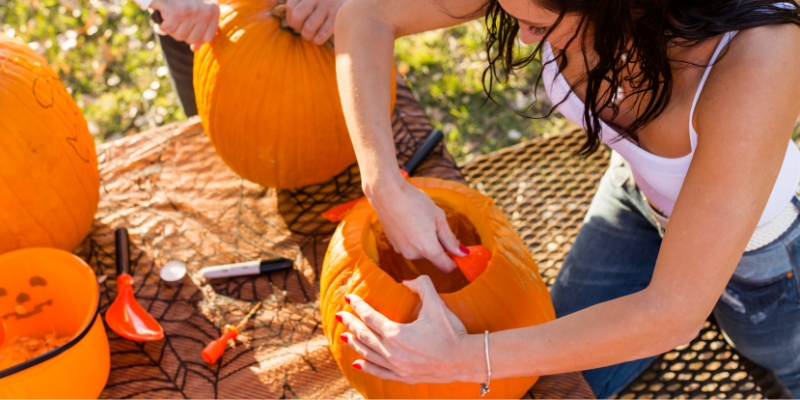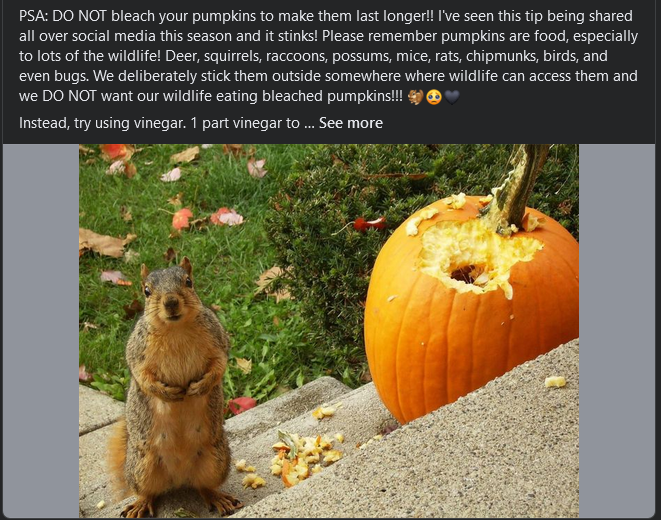Palm Coast Local
Locals Helping Locals

How To Use Bleach To Preserve Your Pumpkin and Not Harm Wildlife.
- Details
- Written by: Palm Coast Local
- Parent Category: Business Blog
- Category: Consumer Alert

As the leaves start to turn and the air gets cooler, it's time for pumpkins, and of course, Halloween! And with Halloween comes all sorts of pumpkin-related activities, including the challenge of keeping your artistic and creartive jack-o'-lanterns looking fresh. One popular hack floating around social media suggests using household bleach to extend the life of your pumpkins.

Social Media Post PSA Sharing. Author Unknown.
But hold on—others argue that bleach could be harmful to wildlife. So, what's the real deal? Is bleach a safe solution for your pumpkins, or are you inadvertently causing harm? Let’s break it down!
The Science Behind Bleach and Your Pumpkin
Bleach works by sanitizing the surface of the pumpkin, killing fungi and bacteria that accelerate decomposition. Even if your pumpkin isn’t carved, it’s eventually going to rot under the right conditions. But while bleach effectively fights off these microorganisms, what about the concern that it could harm wildlife?
The key lies in how you use bleach. Bleach contains sodium hypochlorite, which in concentrated amounts can indeed be toxic. However, when properly diluted, bleach breaks down quickly in the environment. In fact, it’s commonly used by farmers to sanitize produce, including pumpkins, without posing a risk to wildlife or humans. When used correctly, bleach does *not* pose an increased risk to your local squirrels or birds.
How to Safely Sanitize Your Pumpkin with Bleach
Here’s the step-by-step guide to safely using bleach to preserve your pumpkin:
1. Clean First: Before applying bleach, wash your pumpkin with water or a mild detergent to remove dirt. Bleach works best on clean surfaces, as dirt and debris can neutralize its effectiveness.
2. Dilute the Bleach: Use a solution of 1 tablespoon of unscented, regular household bleach (not the "splashless" kind) per gallon of water. This concentration is about 200 ppm sodium hypochlorite—safe and effective for pumpkins.
3. Apply the Solution: Use a spray bottle to lightly coat the pumpkin, or if you're dealing with uncarved pumpkins, you can dunk them into the bleach solution. For carved pumpkins, spraying is better to avoid bleach soaking into the exposed flesh.
4. Let It Dry: Allow the pumpkin to air dry fully. This ensures the bleach has time to work, and wiping could spread germs instead of removing them.
Should You Use Bleach on Your Other Produce?
While bleach is great for pumpkins, it’s *not* recommended for other produce you eat. A good rinse with cold water and friction is all you need to clean most fruits and veggies. Bleach and other chemicals should only be used in controlled, professional settings with the right equipment to ensure food safety.
Don’t Want to Use Bleach? What About Vinegar?
If you’d rather not use bleach, vinegar can be an alternative, though it’s less effective as a sanitizer. Vinegar solutions range from 1/3 cup vinegar per cup of water to full-strength vinegar, but there’s limited research on how well it works specifically for pumpkins. While some people swear by it, you may not get the same level of protection as you would with bleach.
Final Thoughts
Bleach, when used properly, is a safe and effective way to prolong the life of your pumpkins without harming wildlife. Just be sure to follow the right dilution and cleaning steps. And while there are other options like vinegar, their effectiveness may not measure up. So this Halloween, feel free to give your pumpkins a little extra TLC—and keep them looking great through the spooky season!
Of course, if you are like me I won't be using any bleach on any of my pumpkins. In conclusion this is truely a personal choice.
Don't forget to wear proptective gloves and use outdoors for proper ventilation when using bleach or any chemical.